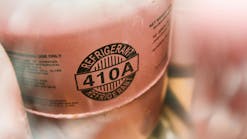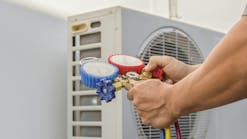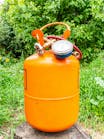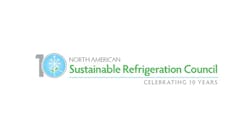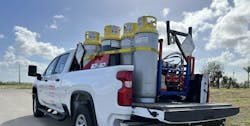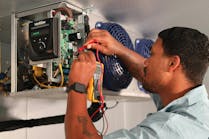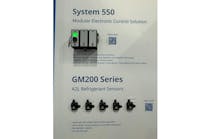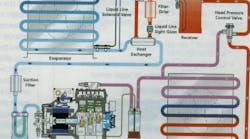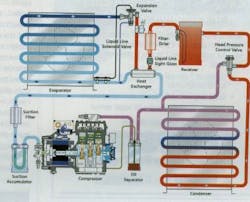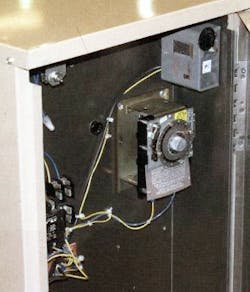EDITOR'S NOTE: This article was updated to include two related videos, and two photos from original print article.
When you're called to service a commercial refrigeration system, you'll encounter numerous defrost control arrangements. In some applications, for example, scheduled defrost periods may not be needed. The normal "off-cycle" of the compressor may be adequate to keep the evaporator coil clear of frost. In other applications, a defrost timer may be necessary to help ensure a clear coil by imposing compressor off cycles periodically. For these applications, the timer initiates an "air defrost" period by shutting off the compressor while the evaporator fans continue to operate. This facilitates the melting of frost on the finned coil surface, using room air.
In other types of scheduled or forced defrost schemes, the evaporator fans shut off while defrost heaters are energized during the defrost period initiated by the timer. The defrost heaters are used to melt accumulated frost off the evaporator coil surfaces and warm the drain pan to allow the defrostcondensate to exit down the drain line without refreezing in the pan. A defrost termination control may be used to end the defrost period based on temperature. Otherwise, the defrost period will end when the defrost timer runs out.
RELATED: CRACKING THE CASE OF UNWANTED LOAD IN COMMERCIAL REFRIGERATION
After the evaporator is defrosted, the evaporator fans may need to remain off until any residual defrost condensate on the coil surface refreezes. This prevents the residue from blowing off the coil and onto the product. This evaporator fan delay period is also used to minimize air pressure increases, which could occur by blowing dense, cold air over a warm coil surface. Temperature or time controls can be used to regulate the fan delay period.
Since defrost requirements vary based on the installation, determine the defrost settings by observing the system operation. Also, discuss system operation with the end-user. You'll need to understand how the refrigerated space is used. What are the busy times for the space? When is the product loaded? What are the conditions of the product, and what door activities are expected? All of these factors can influence your service call.
How Many Defrost Times are Needed?
In order to minimize heat gain or space temperature fluctuations caused by the defrost cycles, keep the number of defrost cycles to the minimum allowed to meet the specific application requirements. For most applications, two to four defrost cycles per day should be adequate. This may not be enough for unique space usages such as blast coolers and freezers, or applications with high product temperature pull-down loads. There may also be higher defrost requirements during certain days of the week (such as loading day), that must be considered when setting up a defrost schedule.
Keep in mind that most end-users won't want a defrost period during busy times, heavy activity, or product loading. Numerous door openings during these times allow warm, moist air to enter the refrigerated space. This can cause increased frost buildup on the evaporator coil surface.
One approach to minimizing frost accumulation on the evaporator is to ask your end-users to train their employees on good door opening practices. By entering and exiting the refrigerated space quickly and not leaving the door open any longer than absolutely necessary, employees can minimize the amount of warm, moist air that enters the refrigerated space.
However, there is another approach that has been used quite successfully to minimize the amount of frost that accumulates on the evaporator coil surface. In order to minimize the amount of warm, moist air entering the room, shut off the refrigeration system and fan motors during the loading cycle. By not operating the evaporator fan motors when the doors are open, the air turbulence and negative pressure areas that cause more air to enter the room are minimized. While room temperature may suffer for a short period of time with this scheme, its recovery is quick when the system is put back into operation.
How Long Should the Defrost Cycle Last?
Keep the length of the defrost cycle to a minimum. The cycle should be long enough to clear the coil of frost with minimal heat gain into the space, but short enough to prevent " steaming," which occurs if the evaporator coil gets too hot. Defrost cycles are normally time-initiated and temperature-terminated, with a fail-safe time backup. The temperature termination setpoint controls the length of the defrost cycle.
The defrost cycle should be long enough to clear
the coil of frost with minimal heat gain into the space,
but short enough to prevent " steaming,"
which occurs if the evaporator coil gets too hot.
Temperature termination controls can be adjustable or fixed types. The adjustable controls offer more flexibility and some remedial benefits, while the fixed controls are more economical. When setting these controls, position the sensor near a heavily frosted area of the coil. When the coil temperature exceeds 32°F, the frost is melted. To ensure the entire coil has defrosted, set the termination control between 55°F and 60°F. Although the coil temperature reaches this higher temperature, and the room may also warm a bit, the short time of defrosting rarely causes the product temperature to rise.
Steaming causes water and ice droplets to form on the ceiling near the evaporator. In extreme cases, ice will form on the floor under the evaporator. Adjustable temperature termination controls allow for better tweaking of the system to prevent this condition. If your customer complains of icing on the floor, don't increase the number of defrost cycles or the termination temperature. Instead, lower the termination temperature or move the termination sensor on the coil. This will prevent steaming but still clear the coil.
Finally, set a fail-safe time to prevent the system from staying in defrost too long because of defective defrost components or failures. Set this fail-safe for roughly one-third longer than a typical defrost takes to clear the coil.
How Much Evaporator Fan Delay is Needed?
Idle evaporator fan time is needed after defrost to prevent water blow off. The length of this delay or idle time is determined by the length of time it takes for the water, left on the coil from the completed defrost cycle, to refreeze.
A typical fan delay is set to turn on the fans at a temperature setting below freezing, thus ensuring that no water is blown from the coil onto the floor or product. You can keep this temperature fan delay control separate from the defrost termination temperature control or combine it into one control. These controls are available with adjustable or fixed settings.
Some defrost termination fan delay (DTFD) switches aren't mounted directly to tubes carrying refrigerant. Instead, they're mounted to the tube sheet or coil endplate. For initial, warm room startup, it may be necessary to jumper the fan delay to start the fans and reduce the risk of liquid refrigerant returning to the compressor because of the slow response time of this type of DTFD.
Every system is different but remember: the fewest amount of defrosts for the shortest amount of time needed to clear the evaporator will give your customers the most efficiency and satisfactory operation from their equipment.
Joseph Jones is the training manager for Heatcraft Refrigeration Products LLC, Stone Mountain, GA. He has more than 36 years of experience in the air conditioning industry.

